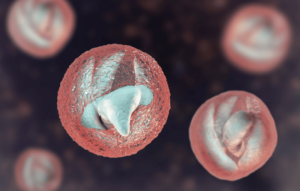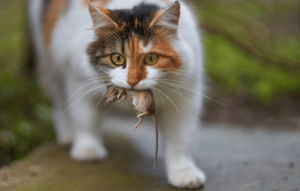In the quiet corners of our everyday lives, a strange threat silently impacts millions without their knowledge – toxoplasmosis. This infection is caused by the microscopic parasite Toxoplasma gondii. Despite its small size, the effects of this parasite can be pretty big, affecting both human and animal health in subtle but significant ways.
Toxoplasmosis is a global issue, with estimates suggesting that over a third of the world’s population carries the parasite. Yet, many remain unaware of its presence and potential dangers. The parasite’s ability to quietly infect and persist in its hosts has earned it the reputation of a ‘silent’ threat, one that can have serious implications for public health, particularly among pregnant women and immunocompromised individuals.
In this blog, we will look into the mysterious world of toxoplasmosis, uncovering its bizarre lifecycle, modes of transmission, and the often-overlooked health impacts it can have. We will also explore the environmental factors that contribute to its spread and discuss effective prevention and control measures. By shedding light on this hidden issue, we aim to inform and empower you to protect yourself and your loved ones from this strange and silent threat.
The Bizarre Lifecycle of Toxoplasmosis
Toxoplasma gondii, the parasite responsible for toxoplasmosis, boasts a fascinating and complex lifecycle. This organism primarily thrives in cats, which serve as its definitive hosts. Within a cat’s intestines, T. gondii undergoes sexual reproduction, producing oocysts that are excreted in the cat’s feces. These oocysts can then contaminate soil, water, and vegetation, lying in wait for new hosts.
and complex lifecycle. This organism primarily thrives in cats, which serve as its definitive hosts. Within a cat’s intestines, T. gondii undergoes sexual reproduction, producing oocysts that are excreted in the cat’s feces. These oocysts can then contaminate soil, water, and vegetation, lying in wait for new hosts.
When other animals, such as rodents, birds, or livestock, ingest these oocysts, they become intermediate hosts. Within these hosts, T. gondii forms tissue cysts, particularly in the muscles and brain. When a cat preys on an infected intermediate host, the lifecycle completes its circle as the parasite returns to its definitive feline host.
Transmission
Humans can become incidental hosts in this intricate lifecycle. The primary routes of human infection include consuming undercooked meat from infected animals, ingesting water or food contaminated with oocysts, and accidentally ingesting oocysts from soil or surfaces contaminated by cat feces. Humans who own cats are obviously at much greater risk of exposure and infection. Additionally, pregnant women can transmit the infection to their unborn children, a scenario fraught with some severe consequences.
Wild Manipulation of Host Behavior
One of the most bizarre and fascinating aspects of Toxoplasma gondii is its ability to manipulate the behavior of its intermediate hosts. In a striking example of this manipulation, rats infected with T. gondii exhibit a complete reversal of their innate fear response to cat odors. Normally, the scent of a cat induces rapid, innate, and stereotyped defensive behaviors in rats, a response shaped by evolutionary pressures to avoid predation. However, infected rats actually approach the cat odors they typically avoid. This behavior change is believed to be a remarkable example of a parasite manipulating a mammalian host for its own benefit, ensuring the parasite’s return to the cat for sexual reproduction.
Research has shown that Toxoplasma infection specifically alters neural activity in the limbic brain areas necessary for innate defensive behavior in response to cat odor. Moreover, Toxoplasma increases activity in nearby limbic regions associated with sexual attraction when the rat is exposed to cat urine. This compelling evidence suggests that Toxoplasma overwhelms the innate fear response by causing, in its stead, a type of sexual attraction to the normally aversive cat odor. Such a sophisticated level of host manipulation underscores the evolutionary success of Toxoplasma gondii and highlights the intricate interplay between parasites and their hosts.
Toxoplasmosis often flies under the radar because its routes of transmission are embedded in everyday activities. Gardening, handling raw meat, and even cleaning a cat’s litter box are common actions that can expose individuals to this parasite. This silent and pervasive nature makes toxoplasmosis a unique challenge in environmental health.
The Health Impacts of Infection
Acute Infection
In many cases, an acute toxoplasmosis infection goes unnoticed. Symptoms, if they appear at all, often mimic those of the flu: swollen lymph nodes, muscle aches, and mild fever. For healthy individuals, these symptoms typically resolve without medical intervention. However, for those with weakened immune systems, such as individuals with HIV/AIDS or those undergoing chemotherapy, toxoplasmosis can lead to severe complications. These can include encephalitis, a potentially life-threatening brain inflammation, and damage to other organs such as the eyes and lungs.
Chronic Infection
The long-term health implications of toxoplasmosis are more insidious and can be far-reaching. Once inside the body, Toxoplasma gondii forms cysts in muscle tissue and the brain, where it can remain dormant for years. Chronic toxoplasmosis has been linked to various mental health disorders and neurological conditions. Some studies suggest that infection may increase the risk of schizophrenia, bipolar  disorder, and even personality changes. The exact mechanisms behind these associations are still under investigation, but they highlight the potential for this parasite to affect human health in subtle yet profound ways.
disorder, and even personality changes. The exact mechanisms behind these associations are still under investigation, but they highlight the potential for this parasite to affect human health in subtle yet profound ways.
Risks for Pregnant Women
Pregnant women are particularly vulnerable to the dangers of toxoplasmosis. If a woman becomes infected during pregnancy, the parasite can cross the placental barrier and infect the developing fetus, leading to congenital toxoplasmosis. This condition can cause severe outcomes such as miscarriage, stillbirth, or birth defects like hydrocephalus (water on the brain) and chorioretinitis (eye inflammation leading to blindness). To mitigate these risks, pregnant women are advised to take specific precautions, such as avoiding contact with cat litter and ensuring that all meat is thoroughly cooked before consumption.
Understanding these health impacts underscores the importance of awareness and preventive measures against toxoplasmosis. By recognizing the potential dangers, individuals can take steps to protect themselves and their families from this strange and silent threat.
Environmental Factors and Spread
The environment plays a crucial role in the spread of Toxoplasma gondii. Oocysts shed by infected cats can persist in soil, water, and on surfaces for months, remaining infectious. Environmental conditions such as temperature, humidity, and soil type can influence the survival and transmission of these oocysts. Urbanization and changing landscapes further exacerbate the spread, as increased human-cat interactions and changes in land use create more opportunities for contamination.
Animal Hosts and Human Interaction
Cats, as the definitive hosts of T. gondii, are central to the parasite’s lifecycle. When cats defecate in gardens, sandboxes, or other outdoor areas, they introduce oocysts into the environment. Other animals, including livestock and wildlife, can ingest these oocysts, becoming intermediate hosts. Human activities such as gardening, farming, and interacting with pets can inadvertently lead to the ingestion of oocysts.
Impact of Urbanization
Urbanization intensifies the spread of T. gondii by increasing the density of both cat populations and human communities. The proximity of these populations raises the likelihood of contamination. Moreover, urban environments often lack sufficient waste management systems, contributing to the persistence and spread of oocysts. Public spaces, playgrounds, and communal gardens can become hotspots for exposure, highlighting the need for effective environmental management and hygiene practices.
Human Activities and Lifestyle
Daily human activities significantly influence the risk of toxoplasmosis infection. For instance, consuming undercooked or contaminated meat, handling raw meat, and improper hand hygiene after gardening or cleaning cat litter boxes are common risk factors. Additionally, practices such as composting and the use of untreated water sources can introduce T. gondii into households and communities.
Prevention and Mitigation
Preventing toxoplasmosis starts with good hygiene. Properly handling and cooking food is crucial — make sure all meat is thoroughly cooked to an internal temperature that kills Toxoplasma gondii. Wash fruits and vegetables thoroughly to remove any potential contamination. After handling raw meat, gardening, or cleaning a cat’s litter box, wash your hands with soap and water to minimize the risk of ingesting oocysts.
Practices for Cat Owners
Cat owners can take specific measures to reduce the risk of toxoplasmosis. Clean the litter box daily, as the oocysts become infectious one to five days after being shed. Wear gloves when changing the litter and wash your hands afterward. If possible, pregnant women and immunocompromised individuals should avoid handling cat litter altogether. Keep cats indoors to prevent them from hunting and becoming infected with T. gondii.

Environmental Measures
Controlling the spread of Toxoplasma gondii in public spaces is essential. Municipalities should ensure proper waste management and sanitation to prevent contamination of soil and water. Public awareness campaigns can educate communities about the risks and safe practices to reduce exposure. For example, advising against using untreated water sources for drinking or washing food can help lower infection rates.
Public Awareness
Raising awareness about toxoplasmosis is key to prevention. Educational programs can inform people about the risks, transmission routes, and prevention strategies. Regular screenings and early detection can help identify and manage infections before they lead to severe health issues. Communities can work together to promote safe practices and support measures that protect public health.
By adopting these preventive measures and increasing public awareness, we can effectively mitigate the risk of toxoplasmosis and better protect our health and environment.
Conclusion
Toxoplasmosis represents a strange and silent threat that often goes unnoticed in our daily lives. This parasitic infection of Toxoplasma gondii has the potential to affect millions globally, with its transmission routes embedded in routine activities like gardening, handling raw meat, and caring for pets. The insidious nature of the parasite, capable of manipulating its hosts and causing severe health implications, particularly for pregnant women and immunocompromised individuals, underscores the importance of awareness and preventive measures.
parasite, capable of manipulating its hosts and causing severe health implications, particularly for pregnant women and immunocompromised individuals, underscores the importance of awareness and preventive measures.
By understanding the lifecycle of T. gondii, recognizing the ways it spreads, and implementing straightforward hygiene practices, we can significantly reduce the risk of infection. Safe practices for cat owners, proper food handling, and public awareness campaigns are vital components in this effort. Moreover, addressing environmental factors and promoting effective sanitation can help control the spread of this parasite in our communities.
In conclusion, staying informed and proactive about toxoplasmosis is crucial for protecting our health and the health of those around us. By taking simple, yet effective steps, we can mitigate the impact of this silent threat and create a safer environment for everyone.











